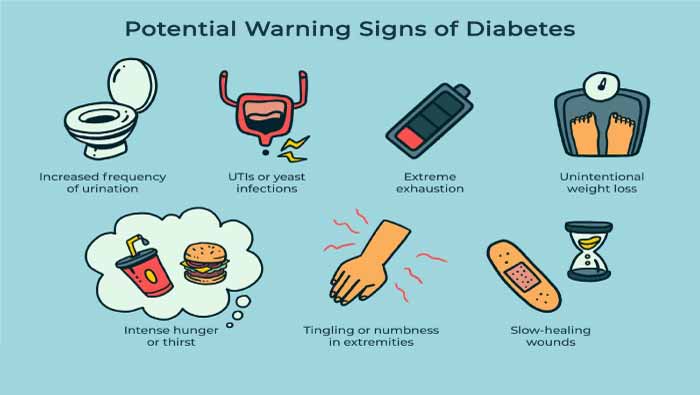There are a number of symptoms of diabetes. Among them are dry mouth, itchy skin and excessive thirst. Your doctor will do certain tests if your diabetes is not well controlled. Your doctor can also monitor your cholesterol, triglycerides, and kidney function levels. You should see your doctor at least once a year, and more often if you are diabetic and have an eye disease. Should also see your dentist at least every six months and make sure they are aware of your diabetes. You may need to take medicines such as metformin or vitamin B12, which can lower your blood sugar levels.
Dry mouth
Dry mouth is one of the most common symptoms of diabetes. This condition can lead to a variety of problems, including loss of taste, pain, and difficulty chewing and swallowing. It should not be taken lightly, but can be controlled with proper treatment. People with diabetes should discuss their symptoms with their healthcare provider to find the right treatment for them. They should also practice good oral hygiene, which can help reduce symptoms.
If you experience dry mouth diabetes symptoms, talk to your healthcare provider as soon as possible. This condition may not be related to diabetes, but it is an early symptom of the condition. In many cases, people with diabetes may not even realize they have the condition. Diabetics are more likely to develop this condition if they don’t have enough saliva. Symptoms of dry mouth include bad breath, new spaces in the teeth, and pain in the mouth and throat.
Itchy skin
People with symptoms of diabetes often experience an increased level of itchy skin. In some patients, the itching is so intense that it can lead to agitation and excessive scratching. This can lead to an infection, which can lead to more pain and discomfort. Itchy skin in diabetes can be caused by several causes, such as a bacterial or yeast infection, dry skin, or reduced blood flow to the extremities. It can also be a reaction to new diabetes medications.
People with diabetes should see a doctor for the condition. The first step is to check your blood sugar levels. People with diabetes are at a higher risk of developing a rash if their blood sugar levels are too high. They should also check the skin on their hands, arms, and legs, as they can be affected by a variety of skin conditions.
Fungal infections are another cause of itchy skin in diabetics. These fungi grow in warm, moist places, such as skin folds. Common fungal infections include athlete’s foot, jock itch, and ringworm. People with diabetes have a higher risk of developing these infections, so it’s important to monitor blood sugar levels regularly and follow a healthy diet to prevent yeast infections.
Excessive thirst
Excessive thirst is one of the symptoms of ‘Big 3’ diabetes and can indicate high blood sugar. However, increased thirst in a person with diabetes is not always a sign of higher blood glucose levels. If you suspect you may have diabetes, you can have a blood glucose test to determine what’s causing your excessive thirst. If you do not have access to such a test, you should talk to your health care provider.
Excessive thirst is a sign of diabetes and other serious health conditions. It is often caused by high blood sugar, leading to a condition called polydipsia. This condition results in an increased need for water and can last for days or even weeks. That’s why drinking plenty of water is essential for the normal functioning of the body.
If you notice excessive thirst, you should seek medical attention as soon as possible. It’s important to know that diabetes can lead to many long-term problems if left untreated. This condition can also lead to kidney damage, which is another common symptom.
Kidney damage
Diabetes damages small blood vessels, which can hinder the kidneys’ ability to remove waste materials from the blood. When this happens, the kidneys must work harder to compensate for the damaged blood vessels. This causes the patient to retain more water and salt in the urine than normal. This fluid can also produce bacteria, which causes infections.
Although there is no single cause for kidney damage, some risk factors have been linked to diabetes. One of the risk factors is elevated blood pressure. In both type 1 and type 2 diabetes, hypertension usually precedes or follows the onset of microalbuminuria. This association is thought to be due to loss of renal self-regulation, causing hypertension to be transmitted to vulnerable glomerular capillaries.
Poor blood glucose control can also damage the kidneys. This can cause accumulation of waste and fluids, a condition known as diabetic nephropathy. Diabetics should be screened regularly for kidney disease to catch this condition early. These tests detect the presence of protein in the urine, as well as blood tests that measure kidney function. If the kidneys are not working properly, dialysis or a transplant may be needed.
Nerve damage is a diabetes symptoms
If you have diabetes, you may experience symptoms related to nerve damage. These symptoms are not immediately apparent and can take years to develop. However, if you catch them early enough, you may be able to prevent more serious damage from occurring. These symptoms vary, depending on the area of the body affected and the type of nerves affected. For example, if you have nerve damage in your feet, you may experience tingling and pain in your feet.
Other signs and symptoms include dizziness and weakness. These symptoms are often related to circulation and blood pressure, so your doctor may recommend that you raise your head or sit slowly. He or she may also prescribe medicine to control high blood pressure or increase the amount of salt you eat. Diabetics are at high risk of developing nerve damage, but this condition can be prevented by keeping blood glucose levels within a target range.
If you suspect you have diabetes, it’s best to contact your doctor as soon as possible. Nerve damage caused by diabetes can be very painful and the sooner it is treated, the better the outcome. For this reason, it is important to regularly monitor blood glucose levels.
Rapid increases and decreases in blood glucose levels
People with diabetes often experience rapid rises and falls in blood glucose levels. This can happen for several reasons. For example, high glucose levels can cause a person to experience thirst and fatigue. In some people, high blood sugar can also be caused by a missed insulin injection. Other reasons for high blood sugar include physical exercise, emotional stress, and infections.
The best way to treat your diabetes is to follow the advice of your care team. If you notice your blood glucose levels rising too quickly, you should immediately contact your healthcare provider and order a blood test. Your health care provider may adjust your medicines or give you more insulin if needed.
People with diabetes should also check their blood glucose level before driving or operating machinery. Despite being able to drive, diabetics should avoid alcohol or alcoholic beverages when their blood sugar is low. Low blood glucose levels can also cause symptoms such as headache, tremors, sweating, and pounding heartbeat. It is important to remember that the goal for your blood glucose level is between 70 to 100 mg/dl fasting and less than 140 mg/dl 2 hours after eating.
High blood sugar levels in people with diabetes can lead to serious complications, such as nerve loss, kidney damage, and increased risk of cardiovascular disease. Although hyperglycemia does not cause immediate symptoms, it is essential to control blood sugar levels as they rise and fall. In some cases, people with diabetes need medication, but they can moderate their blood sugar levels with lifestyle changes.
Family history diabetes symptoms
A family history of diabetes is a major risk factor for developing type 2 diabetes. Several factors, including lifestyle and diet, can increase a person’s risk. A study of Japanese participants found that an individual’s family history of diabetes significantly increased their risk of developing diabetes. The study also found that alcohol consumption and obesity were associated with diabetes, suggesting that the disease may be influenced by environmental factors.
Study design was prospective and sample size was large. However, some of the results were not significant. While previous cohort studies used self-administered questionnaires, this study is based on annual examinations and determination of fasting glucose levels and hemoglobin A1c. However, several limitations must be taken into account, including the fact that participants reported whether they had a family history of diabetes and that the study assessed diabetes risk only once at baseline. This can lead to classification errors.


